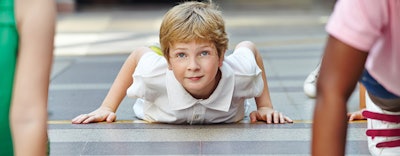
Not every kid likes to play sports. For the athletically disinclined, a game of gym class dodgeball or basketball can be an anxiety-inducing experience. In fact, a recent study by researchers at Brigham Young University found that kids who were ridiculed in gym class (by peers and teachers) were less likely to engage in physical activity one year later — not good news for a nation facing an obesity and sedentary-lifestyle epidemic.
That's assuming kids are exposed to physical education at all, as gym classes and recess periods have frequently become the victims of dwindling budgets and heightened academic standards.
However, faced with a growing body of research linking physical activity to better academic performance, schools that had once marginalized recess and gym are doing an about-face. Across the country, school districts are not only bringing back gym class but rethinking the entire physical education experience, putting more emphasis on education. "The country depends on us to do something different than what we have been doing," Dolly Lambdin, president of Society of Health and Physical Educators (SHAPE) told the Washington Post. "We cared too much about who is the best, who can do the most pushups, and not nearly enough about what it means to be healthy and physically active for a lifetime."
When classes resume next month, students at many schools will find gym class to be a bit different than what they remember. The "New PE," as its called, focuses on teaching students about the impact of physical activity on overall health and fitness, trading basketballs and hockey sticks for heart rate monitors, pedometers and even exergaming. Sports and competition have not been forgotten, though lifetime sports like rock climbing and archery emphasize continual improvement as opposed to sports that focus on a "win or lose" outcome.
Agencies like SHAPE have been promoting such a model for nearly two decades, but programs like First Lady Michelle Obama's "Let's Move! Active Schools" are helping to build awareness, provide resources and give the movement greater momentum. As evidence, the Presidential Physical Fitness Test, a decades-old benchmark for measuring fitness in schools, was officially retired last year. Gone are badges based on the number of pushups or pullups a student can do, or how long it takes them to run a mile. The outdated test has been replaced with the Fitnessgram, which evaluates students according to research-backed targets of fitness based on their age and gender.
Critics of the New PE movement argue that such programming is too soft on children, failing to instill character-building lessons about competition. But then, children who are turned off to sports and recreational activities altogether because of their gym class experiences are even less likely to learn.
 Click here to read 1999 article
Click here to read 1999 article
Looking Back: 1999
While national involvement is drawing more attention to the New PE, a shift has been under way for years. In December 1999, then-managing editor Michael Popke took a look at the tactics some schools were employing to keep kids engaged. Check out the full article in PDF format by clicking the image.
This article originally appeared in the August 2014 issue of Athletic Business under the headline, "Educational Movement."





































